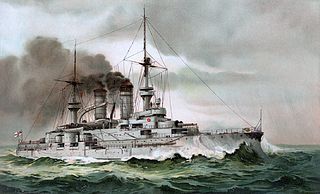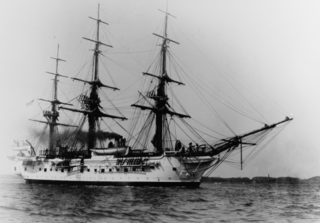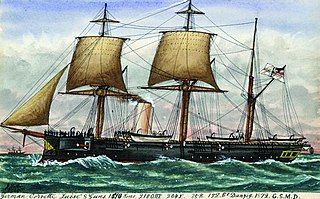
SMS Friedrich der Grosse was an ironclad turret ship built for the German Kaiserliche Marine. She was the second of three Preussen-class ironclads, in addition to her two sister-ships Preussen and Grosser Kurfürst. Named for Frederick the Great, she was laid down at the Imperial Dockyard in Kiel in 1871 and completed in 1877. Her main battery of four 26 cm (10 in) guns was mounted in a pair of twin gun turrets amidships.

SMS Zähringen was the third Wittelsbach-class pre-dreadnought battleship of the German Imperial Navy. Laid down in 1899 at the Germaniawerft shipyard in Kiel, she was launched on 12 June 1901 and commissioned on 25 October 1902. Her sisters were Wittelsbach, Wettin, Schwaben and Mecklenburg; they were the first capital ships built under the Navy Law of 1898, brought about by Admiral Alfred von Tirpitz. The ship, named for the former royal House of Zähringen, was armed with a main battery of four 24 cm (9.4 in) guns and had a top speed of 18 knots.

SMS Gneisenau was a Bismarck-class corvette built for the German Imperial Navy in the late 1870s. The ship was named after the Prussian Field Marshal August von Gneisenau. She was the fifth member of the class, which included five other vessels. The Bismarck-class corvettes were ordered as part of a major naval construction program in the early 1870s, and she was designed to serve as a fleet scout and on extended tours in Germany's colonial empire. Gneisenau was laid down in June 1877, launched in September 1879, and was commissioned into the fleet in October 1880. She was armed with a battery of fourteen 15 cm (5.9 in) guns and had a full ship rig to supplement her steam engine on long cruises abroad.

SMS Moltke was a Bismarck-class corvette built for the German Imperial Navy in the late 1870s. The ship was named after the Prussian Field Marshal Helmuth von Moltke the Elder. She was the fourth member of the class, which included five other vessels. The Bismarck-class corvettes were ordered as part of a major naval construction program in the early 1870s, and she was designed to serve as a fleet scout and on extended tours in Germany's colonial empire. Moltke was laid down in July 1875, launched in October 1877, and was commissioned into the fleet in April 1878. She was armed with a battery of ten 15 cm (5.9 in) guns and had a full ship rig to supplement her steam engine on long cruises abroad.

SMS Wettin was a pre-dreadnought battleship of the Wittelsbach class of the German Kaiserliche Marine. She was built by Schichau Seebeckwerft in Danzig. Wettin was laid down in October 1899, and was completed October 1902. She and her sister ships—Wittelsbach, Zähringen, Schwaben and Mecklenburg—were the first capital ships built under the Navy Law of 1898. Wettin was armed with a main battery of four 24 cm (9.4 in) guns and had a top speed of 18 knots.

SMS Württemberg was one of four Sachsen-class armored frigates of the German Kaiserliche Marine. Her sister ships were Sachsen, Bayern, and Baden. Württemberg was built in the AG Vulcan shipyard in Stettin from 1876 to 1881. The ship was commissioned into the Imperial Navy in August 1881. She was armed with a main battery of six 26 cm (10.2 in) guns in two open barbettes.

SMS Victoria Louise was the lead ship of her class of protected cruisers, built for the German Imperial Navy in the late 1890s. She was laid down at the AG Weser shipyard in 1895, launched in March 1897, and commissioned into the German fleet in February 1899. She was named after Princess Victoria Louise, the daughter of Kaiser Wilhelm II. The ship was armed with a battery of two 21 cm guns and eight 15 cm guns and had a top speed of 19.2 knots.

SMS Vineta was a protected cruiser of the Victoria Louise class, built for the German Imperial Navy in the 1890s. Vineta was laid down at the AG Vulcan shipyard in 1895, launched in April 1897, and commissioned into the Navy in July 1898. The ship, named for the semi-legendary medieval town of Vineta, was armed with a battery of two 21 cm guns and eight 15 cm guns and had a top speed of 19 knots.

SMS Amazone was the sixth member of the ten-ship Gazelle class of light cruisers that were built for the German Kaiserliche Marine in the late 1890s and early 1900s. The Gazelle class was the culmination of earlier unprotected cruiser and aviso designs, combining the best aspects of both types in what became the progenitor of all future light cruisers of the Imperial fleet. Built to be able to serve with the main German fleet and as a colonial cruiser, she was armed with a battery of ten 10.5 cm (4.1 in) guns and a top speed of 21.5 knots.

SMS Berlin was the second member of the seven-vessel Bremen class of light cruisers, built for the German Kaiserliche Marine in the early 1900s. She and her sister ships were ordered under the 1898 Naval Law that required new cruisers be built to replace obsolete vessels in the fleet. The design for the Bremen class was derived from the preceding Gazelle class, utilizing a larger hull that allowed for additional boilers that increased speed. Named for the German capital of Berlin, the ship was armed with a main battery of ten 10.5 cm (4.1 in) guns and had a top speed of 22 knots.

SMS Stein was a Bismarck-class corvette built for the German Imperial Navy in the late 1870s. The ship was named after the Prussian statesman Heinrich Friedrich Karl vom und zum Stein. She was the sixth member of the class, which included five other vessels. The Bismarck-class corvettes were ordered as part of a major naval construction program in the early 1870s, and she was designed to serve as a fleet scout and on extended tours in Germany's colonial empire. Stein was laid down in 1878, launched in September 1879, and was commissioned into the fleet in October 1880. She was armed with a battery of twelve 15 cm (5.9 in) guns and had a full ship rig to supplement her steam engine on long cruises abroad.

SMS Stosch was a Bismarck-class corvette built for the German Imperial Navy in the late 1870s. The ship was named for Admiral Albrecht von Stosch, the first chief of staff of the newly created Imperial Navy. She was the third member of the class, which included five other vessels. The Bismarck-class corvettes were ordered as part of a major naval construction program in the early 1870s, and she was designed to serve as a fleet scout and on extended tours in Germany's colonial empire. Stosch was laid down in November 1875, launched in October 1876, and was commissioned into the fleet in June 1879. She was armed with a battery of ten 15 cm (5.9 in) guns and had a full ship rig to supplement her steam engine on long cruises abroad.

The Bismarck-class corvettes were a class of six corvettes built for the German Kaiserliche Marine in the 1870s. The six ships were Bismarck, Blücher, Stosch, Moltke, Gneisenau, and Stein. The Bismarck-class corvettes were ordered as part of a major naval construction program in the early 1870s, and they were designed to serve as fleet scouts and on extended tours in Germany's colonial empire. The ships were armed with a battery of between ten and sixteen 15 cm (5.9 in) guns and they had a full ship rig to supplement their steam engine on long cruises abroad. One ship, Blücher, was converted into a torpedo testing and training ship shortly after she was completed, having her guns replaced with a variety of torpedo launchers.

SMS Blitz was an aviso of the German Kaiserliche Marine built in the early 1880s. She was the lead ship of her class, which included one other vessel, SMS Pfeil. Her primary offensive armament consisted of a bow-mounted torpedo tube, and she was armed with a battery of light guns to defend herself against torpedo boats, a sign of the growing importance of torpedoes as effective weapons in the period. The Blitz class featured a number of innovations in German warship design: they were the first steel hulled warships and the first cruiser-type ships to discard traditional sailing rigs.

SMS Pfeil was an aviso of the Imperial German Navy, the second and final member of the Blitz class. Her primary offensive armament consisted of a bow-mounted torpedo tube, and she was armed with a battery of light guns to defend herself against torpedo boats, a sign of the growing importance of torpedoes as effective weapons in the period. The Blitz class featured a number of innovations in German warship design: they were the first steel hulled warships and the first cruiser-type ships to discard traditional sailing rigs.

SMS Nixe was a screw corvette built for the German Kaiserliche Marine in the 1880s. She was laid down in August 1883, launched in July 1885, and commissioned into the fleet in April 1886. Hopelessly out of date even by the time she was ordered in 1882 and possessing insufficient gun power or speed, she was nevertheless completed as designed. In addition to those shortcomings, she proved to be difficult to handle in service and was particularly affected by wind.

SMS Luise was a steam corvette of the German Kaiserliche Marine. She was the second member of the Ariadne class, which included two other ships, Ariadne and Freya. Ordered as part of a large naval expansion program after the Austro-Prussian War, she was laid down in 1871 during the Franco-Prussian War. She was launched in December 1872 and completed in June 1874. Luise was a small vessel, armed with a battery of just eight guns.

SMS Freya was a steam corvette of the German Kaiserliche Marine. She was the third member of the Ariadne class, which included two other ships, Ariadne and Luise. Ordered as part of a large naval expansion program after the Austro-Prussian War, she was laid down in 1872 after the Franco-Prussian War. She was launched in December 1874 and completed in October 1876. Freya was built to a different design than her sisters, being longer and carrying a heavier battery of twelve guns.

SMS Prinz Adalbert was a steam corvette of the German Kaiserliche Marine, the second and final member of the Leipzig class. She was laid down in 1875 at the AG Vulcan shipyard in Stettin, was launched in June 1876, and was commissioned into the fleet in August 1877. Originally named Sedan after the Battle of Sedan of the Franco-Prussian War, she was renamed Prinz Adalbert to avoid antagonizing France in 1878, less than a decade after the battle.






















